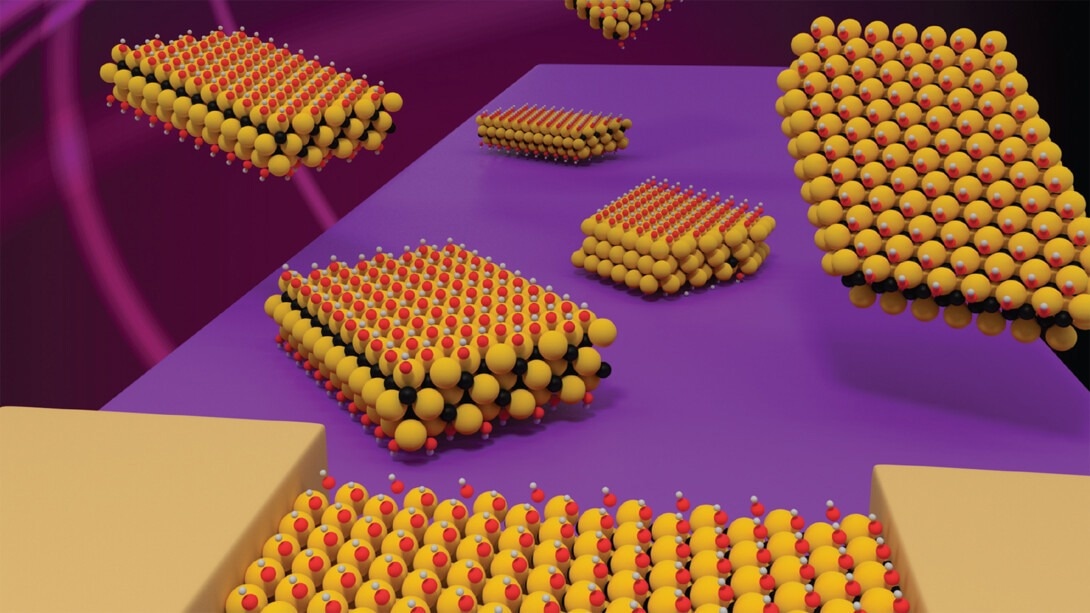Reviewed by Lexie CornerOct 29 2024
A team of researchers from the University of Nebraska–Lincoln investigated the physical characteristics of MXenes, a rapidly growing family of two-dimensional materials with potential for diverse nanotechnology applications. The study was published in the journal Matter.
 This rendering depicts the arrangement of a two-dimensional nanomaterial featuring three titanium atoms and two carbon atoms. The material is part of the so-called MXene family, which has shown promise in the realms of energy storage and water purification. Image Credit: Alexey Lipatov, Advanced Electronic Materials, Wiley-VCH
This rendering depicts the arrangement of a two-dimensional nanomaterial featuring three titanium atoms and two carbon atoms. The material is part of the so-called MXene family, which has shown promise in the realms of energy storage and water purification. Image Credit: Alexey Lipatov, Advanced Electronic Materials, Wiley-VCH
The team’s research builds on nearly two decades of studies into graphenes, a family of 2D materials with broad applications but some limitations when compared to MXenes (pronounced “maxenes”).
MXenes consist of atomically thin layers of transition metal carbides, nitrides, or carbonitrides. These layers derive from the so-called MAX phase, with “M” representing a transition metal like titanium or chromium, “A” representing an element such as aluminum, and “X” standing for carbon or nitrogen atoms. In this structure, the layers are packed together, creating a layered formation.
To produce MXenes, chemists use a relatively simple, high-yield process involving acidic solutions to etch away the “A” element layers, preserving the remaining layers.
Various MXenes have been synthesized by combining different “M” and “X” elements. According to Principal Researcher and Chemistry Professor Alexander Sinitskii, the Nebraska team has focused on a specific, less-studied MXene form containing atoms of carbon, titanium, and chromium.
“The field is rapidly growing,” Sinitskii said.
MXenes have shown potential in various fields, including biomedical applications, energy storage, water purification, and electromagnetic interference protection.
According to Sinitskii, who is also affiliated with the Nebraska Center for Materials and Nanoscience—a nationally recognized center of excellence that draws on research from three of the four University of Nebraska campuses—the chemical and structural diversity of MXenes, along with their scalability and processability, are key to their versatility. MXenes also feature a large surface area, are highly tunable, respond strongly to light, and are hydrophilic due to oxygen- and hydroxyl-terminated surfaces.
Sinitskii’s team has found that the MXene containing chromium and titanium possesses “a certain set of properties not seen in others.” Previous studies on other MXenes by the Nebraska team indicated an n-type (electron-rich) character and decreased conductivity when exposed to light. In contrast, this new material is the first MXene to exhibit p-type (electron-deficient) properties, with conductivity that increases under illumination.
These are very unusual characteristics for MXenes. In many electronic applications, both n- and p-type materials are required and used in combination. Previously studied MXenes were all n-type, but now we demonstrate the first p-type MXene. This should enable complex structures where complementary MXenes are used together to achieve new electronic functionalities.
Alexander Sinitskii, Department of Chemistry, University of Nebraska-Lincoln
In addition, Sinitskii’s group has produced larger and more consistent flakes of the chromium/titanium carbide MXene than previously available, making them easier to use and study.
The research team includes Saman Bagheri, a Postdoctoral Research Associate in Chemistry; Michael J. Loes, a Chemistry Graduate Student; Haidong Lu, a Research Assistant Professor in Physics and Astronomy; Rashmeet Khurana, a Chemistry Graduate Student; Md. Ibrahim Kholil, a Chemistry Graduate Student; and Alexei Gruverman, a Mach Professor of Physics and Astronomy.
Additional co-authors from the South Dakota School of Mines and Technology are Alexey Lipatov, Khimananda Acharya, and Tula R. Paudel.
Journal Reference:
Bagheri, S., et al. (2024) Synthesis of high-quality large Cr2TiC2T MXene monolayers, their mechanical properties, p-type electrical transport, and positive photoresponse. Matter. doi.org/10.1016/j.matt.2024.08.019.